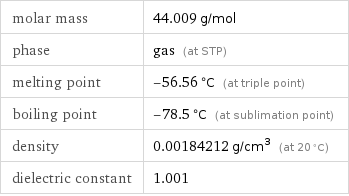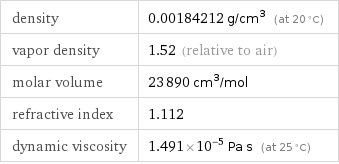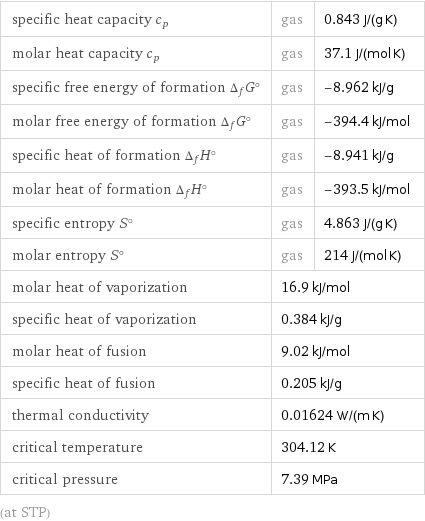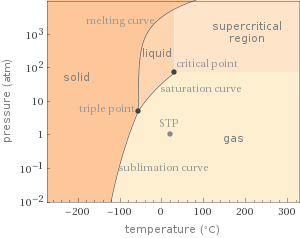Input interpretation

carbon dioxide
Chemical names and formulas

formula | CO_2 name | carbon dioxide alternate names | anhydride carbonique | carbon dixoide, compressed | carbonic anhydride | Freon 744 | R-744 mass fractions | C (carbon) 27.3% | O (oxygen) 72.7%
Lewis structure

Draw the Lewis structure of carbon dioxide. Start by drawing the overall structure of the molecule, ignoring potential double and triple bonds: Count the total valence electrons of the carbon (n_C, val = 4) and oxygen (n_O, val = 6) atoms: n_C, val + 2 n_O, val = 16 Calculate the number of electrons needed to completely fill the valence shells for carbon (n_C, full = 8) and oxygen (n_O, full = 8): n_C, full + 2 n_O, full = 24 Subtracting these two numbers shows that 24 - 16 = 8 bonding electrons are needed. Each bond has two electrons, so in addition to the 2 bonds already present in the diagram add 2 bonds. To minimize formal charge oxygen wants 2 bonds and carbon wants 4 bonds. Identify the atoms that want additional bonds and the number of electrons remaining on each atom: Fill in the 2 bonds by pairing electrons between adjacent highlighted atoms: Answer: | |
3D structure

3D structure
Basic properties

molar mass | 44.009 g/mol phase | gas (at STP) melting point | -56.56 °C (at triple point) boiling point | -78.5 °C (at sublimation point) density | 0.00184212 g/cm^3 (at 20 °C) dielectric constant | 1.001
Gas properties (at STP)

density | 0.00184212 g/cm^3 (at 20 °C) vapor density | 1.52 (relative to air) molar volume | 23890 cm^3/mol refractive index | 1.112 dynamic viscosity | 1.491×10^-5 Pa s (at 25 °C)
Units

Thermodynamic properties

specific heat capacity c_p | gas | 0.843 J/(g K) molar heat capacity c_p | gas | 37.1 J/(mol K) specific free energy of formation Δ_fG° | gas | -8.962 kJ/g molar free energy of formation Δ_fG° | gas | -394.4 kJ/mol specific heat of formation Δ_fH° | gas | -8.941 kJ/g molar heat of formation Δ_fH° | gas | -393.5 kJ/mol specific entropy S° | gas | 4.863 J/(g K) molar entropy S° | gas | 214 J/(mol K) molar heat of vaporization | 16.9 kJ/mol | specific heat of vaporization | 0.384 kJ/g | molar heat of fusion | 9.02 kJ/mol | specific heat of fusion | 0.205 kJ/g | thermal conductivity | 0.01624 W/(m K) | critical temperature | 304.12 K | critical pressure | 7.39 MPa | (at STP)
Phase diagram

Phase diagram
Units
